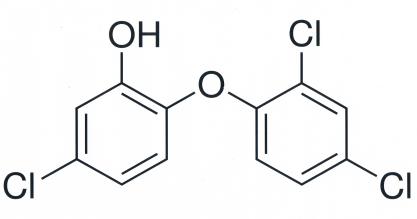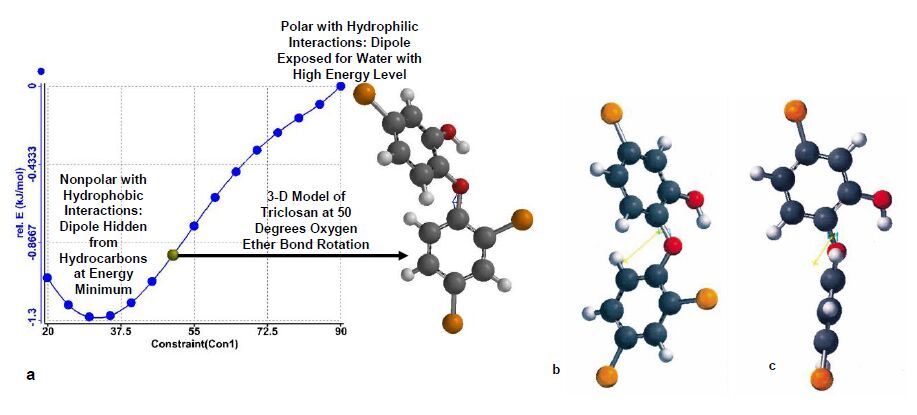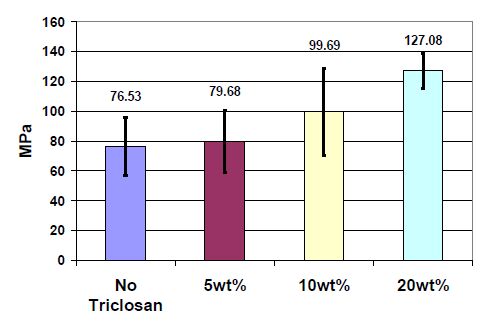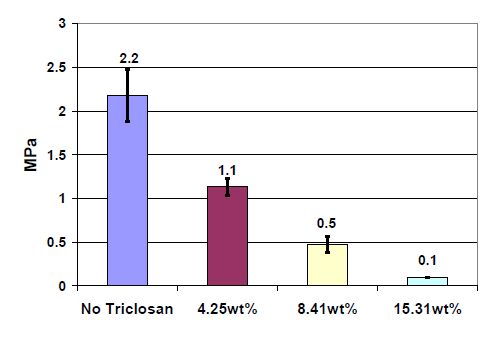|
[1]
|
Ciba Specialty Chemicals (2001) Antimicrobials Irgasan DP 300 Irgacare MP Irgacide LP 10. General information on chemical, physical and microbiological properties. Brochure 2520 Ciba Specialty Chemical Corporation, High Point, NC 27265 Pub. No. AgB2520e.02.2001. Edited in Switzerland.
|
|
[2]
|
European Commission, Scientific Committees on Consumer Safety (SCCS), Opinion on Triclosan, Antimicrobial Resistance. Directorate-General for Health and Consumers, Opinion approved 7th Plenary. SCCP/1251/09, 2010. Available from: http://ec.europa.eu/health/scientific_committees/consumer_safety/docs/sccs_o_023.pdf
|
|
[3]
|
Australian Government, Department of Health and Ageing NICNAS, Priority Existing Chemical Assessment Report No. 30, Triclosan. National Industrial Chemical Notification and Assessment Scheme, Sydney Australia, 2009. Available from: http://www.nicnas.gov.au/publications/car/pec/pec30/pec_30_full_report_pdf.pdf
|
|
[4]
|
Alberts B, Bray D, Lewis J, et al (1994) Small molecules, energy and biosynthesis, In: Molecular Biology of the Cell, 3 Eds., New York: Garland Publishing, Inc., 45-55.
|
|
[5]
|
Brown WH, Foote CS, Everson BL, et al. (2009) Organic Chemistry, 5 Eds., Belmont, CA: Brooks/Cole.
|
|
[6]
|
McMurry J (2004) Organic Chemistry, 6 Eds., Belmont, CA: Thompson Brooks/Cole.
|
|
[7]
|
Nordén B, Edlund U (1987) Intramolecular chelation of chlorinated 2-phenoxyphenols. Acta Chem Scand B41: 194-197.
|
|
[8]
|
Petersen RC (2014) Computational conformational antimicrobial analysis developing mechanomolecular theory for polymer Biomaterials in Materials Science and Engineering. Int J Comp Mat Sci Eng 3: 48.
|
|
[9]
|
Datta S, Lohse DJ (1996) Polymeric Compatibilizers. Munich: Hanser Publishers, 1-59.
|
|
[10]
|
Villaláın J, Mateo CR, Aranda FJ, et al. (2001) Membranotropic effects of the antibacterial agent triclosan. Arch Biochem Biophys 390: 128-136.
|
|
[11]
|
Guillén J, Bernabeu A, Shapiro S, et al. (2004) Location and orientation of triclosan in phospholipid model membranes. Eur Biophys J 33: 448-453.
|
|
[12]
|
Lygre H, Moe G, Skålevik R, et al (2003) Interaction of triclosan with eukaryotic membrane lipids. Eur J Oral Sci 111: 216-222.
|
|
[13]
|
Escalada MG, Russel AD, Maillard JY, et al (2005) Triclosan bacteria interactions: Single or multiple target sites? Lett Appl Microbiol 41: 476-481.
|
|
[14]
|
Regös J, Hitz HR (1974) Investigations on the mode of action of Triclosan, a broad spectrum antimicrobial agent. Zbl Bakt Hyg 1A 226: 390-401.
|
|
[15]
|
Greenman J, McKenzie C, Nelson DGA (1997) Effects of triclosan and triclosan monophosphate on maximum specific growth rates, biomass and hydrolytic enzyme production of Streptococcus sanguis and Capnocytiphaga gingivalis in continuous culture. J Antimicrob Chemother 40: 659-666.
|
|
[16]
|
Roujenikova A, Levy CW, Rowsell S, et al (1999) Crystallographic analysis of triclosan bound to enoyl reductase. J Mol Biol 294: 527-535.
|
|
[17]
|
Stewart MJ, Parikh S, Xiao G, et al (1999) Structural basis and mechanism of enoyl reductase inhibition by Triclosan. J Mol Biol 290: 859-865.
|
|
[18]
|
Dayan FE, Ferreira D, Wang YH, et al (2008) A pathogenic fungi diphenyl ether phytotoxin targets plant enoyl (acyl carrier protein) reductase. Plant Physiol 147: 1062-1071.
|
|
[19]
|
Imazato S, Torii M, Tsuchitani Y (1995) Antibacterial effect of composite incorporating triclosan against Streptococcus mutans. J Osaka Univ Dental School 35: 5-11.
|
|
[20]
|
Malkoc S, Demir A, Sengun A, et al (2005) The effect on shear bond strength of different antimicrobial agents after acid etching. Eur J Orthodontics 27: 484-488.
|
|
[21]
|
Slutzky H, Slutzky-Goldberg I, Weiss EI, et al (2006) Antibacterial properties of temporary filling materials. J Endodontics 32: 214-217.
|
|
[22]
|
Akaki E, Mansur HS, Angelis LH, et al (2005) SEM/EDX and FTIR characterization of a dental resin cement with antibacterial agents incorporated. Key Eng Mater 284-286: 391-394.
|
|
[23]
|
Swofford HW (2001) Antibacterial efficacy of polymer containing triclosan and other antimicrobial additives. Am J Infection Control 29: 428-429.
|
|
[24]
|
Kalyon B, Olgun U (2001) Antibacterial efficacy of triclosan-incorporated polymers. Am J Infection Control 29: 124-125.
|
|
[25]
|
Junker LM, Hay AG (2004) Effects of triclosan incorporation into ABS plastic on biofilm communities. J Antimicrob Chemother 53: 989-996. doi: 10.1093/jac/dkh196

|
|
[26]
|
Rodriquez S (1996) Adhesives, In: Principals of Polymer Systems, 4 Eds., Washington DC: Taylor and Francis, 450-451.
|
|
[27]
|
Park JB, Lakes RS (1992) Tissue Adhesives, In: Biomaterials an Introduction, 2nd Eds., New York: Plenum Pres, 248-249.
|
|
[28]
|
Liang XD, Chen W, Sun G, et al (2014) Experimental study on new self and mutual-aiding occlusive dressing for wound. Chin Med J 127: 1321-1327.
|
|
[29]
|
Houston S, Hodge JW Jr., Ousterhour DK, et al (1969) The effect of α-cyanoacrylate on wound healing. J Biomed Mater Res 3: 281-289.
|
|
[30]
|
Ratner BD, Hoffman AS, Schoen FJ, Lemons JE. (2004) Sutures, In: Biomaterials Science, 2 Eds., San Diego: Elsevier Inc., 614-627
|
|
[31]
|
Jung KH, Oh SJ, Choi KK, et al (2014) Effect of triclosan-coated sutures on surgical site infection after gastric cancer surgery via midline laparotomy. Ann Surg Treat Res 87: 311-318. doi: 10.4174/astr.2014.87.6.311

|
|
[32]
|
Justinger C, Slotta JA, Ningel S, et al (2013) Surgical-site infection after abdominal wall closure with triclosan-impregnated polydioxanone sutures: Results of a randomized clinical pathway facilitated trial (NCT00998907). Surgery 154: 589-595. doi: 10.1016/j.surg.2013.04.011

|
|
[33]
|
Hoshino S, Yoshida Y, Tanimura S, et al (2013) A study of the efficacy of antibacterial sutures for surgical site infection: A retrospective controlled trial. Int Surg 98: 129-132. doi: 10.9738/CC179

|
|
[34]
|
CADTH Rapid Response Report (2014) Antibacterial sutures for wound closure after surgery: A review of clinical and cost-effectiveness and guidelines for use. Rapid Response Report: Summary with Critical Appraisal, 3.
|
|
[35]
|
Daoud FC, Edmiston CE Jr., Leaper D (2013) Meta-analysis of prevention of surgical site infections following incision closure with triclosan-coated sutures: Robustness to new evidence. Surgical Infect 3: 165-181.
|
|
[36]
|
Ricco JB, Assadian A, Schneider F, et al (2012) In vitro evaluation of the antimicrobial efficacy of a new silver-triclosan vs a silver collagen coated polyester vascular graft against methicillin-resistant Staphylococcus aureus. J Vasc Surg 55: 823-829. doi: 10.1016/j.jvs.2011.08.015

|
|
[37]
|
Hernández-Richter T, Schardey HM, Wittmann F, et al (2003) Rifampin and triclosan but not silver is effective in preventing bacterial infection of vascular Dacron graft material. Eur J Vasc Endovasc Surg 26: 550-557. doi: 10.1016/S1078-5884(03)00344-7

|
|
[38]
|
Fisher LE, Hook AL, Ashraf W, et al ( 2015) Biomaterial modification of urinary catheters with antimicrobials to give long-term broadspectrum antibiofilm activity. J Control Release 202: 57-64.
|
|
[39]
|
Petersen RC (2011) Mechanomolecular computational chemistry theory with triclosan models, In: Micromechanics/Electron Interactions for Advanced Biomedical Research. Saarbrücken, Germany: LAP LAMBERT Academic Publishing Gmbh & Co. KG. ISBN 978-3-8443-8856-5, 203.
|
|
[40]
|
Jones GL, Muller CT, O’Reilly M, et al ( 2006) Effect of triclosan on the development of bacterial biofilms by urinary tract pathogens on urinary catheters. J Antimicrob Chemother 57: 266-272.
|
|
[41]
|
Popelka A, Novák I, Lehocký M, et al ( 2012) Anti-bacterial treatment of polyethylene by cold plasma for medical purposes. Molecules 17: 762-785.
|
|
[42]
|
Jin Y, Yip HK (2002) Supragingival calculus: Formation and control. Crit Rev Oral Biol Med 13: 426-441. doi: 10.1177/154411130201300506

|
|
[43]
|
Nabi N, Mukerjee C, Schmid R, et al. (1989) In vitro and in vivo studies on triclosan/PVM/MA copolymer/combination as an anti-plaque agent. Am J Dent 2 Spec No: 197-206.
|
|
[44]
|
Gaffar A, Afflito J, Nabi N, et al (1994) Recent advances in plaque, gingivitis, tartar and caries prevention technology. Int J Dent 44: 63-70.
|
|
[45]
|
Gaffar A, Afflitto J, Nabi N (1997) Chemical agents for the control of plaque and plaque microflora: An overview. Eur J Oral Sci 105: 502-507. doi: 10.1111/j.1600-0722.1997.tb00237.x

|
|
[46]
|
Davies RM, Ellwood RP, Davies GM (2004) The effectiveness of a toothpaste containing triclosan and polyvinyl-methyl ether maleic acid copolymer in improving plaque control and gingival health. J Clin Periodontol 31: 1029-1033. doi: 10.1111/j.1600-051X.2004.00614.x

|
|
[47]
|
Teles RP, Teles FRF (2009) Antimicrobial agents used in the control of periodontal biofilms: effective adjuncts to mechanical plaque control? Braz Oral Res 23: 39-48.
|
|
[48]
|
Bánóczy J, Sari K, Schiff T (1995) Anticalculus efficacy of three dentifrices. Am J Dent 8: 205-208.
|
|
[49]
|
Ciba Specialty Chemicals (2006) PDF, FDA OTC Docket No: 75N-183H. Available from:http://www.fda.gov/ohrms/dockets/dockets/75n0183h/75n-0183h-sup0013-01-vol202.pdf.
|
|
[50]
|
Jones RD, Jampani HB, Newman JL, et al. (2000) Triclosan: A review of effectiveness and safety in health care settings. Am J Infect Control 28: 184-196.
|
|
[51]
|
Russel AD (2004) Whither Triclosan? J Antimicrob Chemother 53: 693-695. doi: 10.1093/jac/dkh171

|
|
[52]
|
Gilbert P, McBain AJ (2002) Literature-based evaluation of the potential risks associated with impregnation of medical devices and implants with Triclosan,” Surg Infect 3: S55-S63.
|
|
[53]
|
Haraszthy VI, Sreenivasan PK, Zambon JJ (2014) Community-level assessment of dental plaque bacteria susceptibility to triclosan over 19 years. BMC Oral Health 14: 61. doi: 10.1186/1472-6831-14-61

|
|
[54]
|
Cullinan MP, Bird PS, Heng NC, et al (2013) No evidence of triclosan-resistant bacteria following long-term use of triclosan-containing toothpaste. J Periodontal Res 49: 220-225.
|
|
[55]
|
Sharma S, Ramya TNC, Surolia A, et al. (2003) Triclosan as a systemic antibacterial agent in a mouse model of acute bacterial challenge. Antimicrob Agents Chemother 47: 3859-3866. doi: 10.1128/AAC.47.12.3859-3866.2003

|
|
[56]
|
Bhargava HN, Loenard PA (1996) Triclosan: Applications and safety. Am J Infect Control 24: 209-218. doi: 10.1016/S0196-6553(96)90017-6

|
|
[57]
|
Food and Drug Administration. Consumer Health Information (2010). Triclosan: What consumers should know. Available from: http://www.fda.gov/consumer
|
|
[58]
|
Seal and Protect. Safety data sheet according to 1907/2006/EC, Article 31, DENTSPLY DeTrey GmbH, De-Trey-Str. 1, D-78467 Konstanz, GERMANY- Departement Analytical Research / Research & Development for technical information.
|




















 DownLoad:
DownLoad: